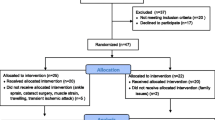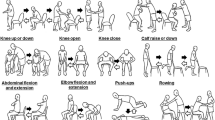Abstract
Background
Resistance training has proven to be an excellent method for counteracting aging physical dysfunctions. However, its application in the liquid environment is not yet fully elucidated.
Aim
To investigate the effects of water-based resistance training (WBRT) with the concentric phase performed as fast as possible, compared to conventional resistance training (CRT), on physical functional capacity, muscle strength, and body composition in older women.
Methods
Thirteen healthy older women participated in the WBRT and 11 in the CRT. Estimation statistics focused on the effect size of the experiment/intervention were used. We also analyzed the intervention effect based on the percentage delta between WBRT and CRT.
Results
The WBRT group showed a negative large effect (d = − 0.922; p = 0.0274) for the timed up and go, and a large effect for chair rise in 30″ and the elbow flex test (d = 1.58; p = 0.0012; d = 2.8; p = 0.01) respectively. Intervention comparisons based on the delta percentage between WBRT and CRT presented an intermediate effect (d = 0.606; p = 0.157) for the stair climb, a large effect (d = 0.988; p = 0.0282) for the timed up and go, and a large negative effect [d = − 1.32 (90.0% CI − 1.92, − 0.646); p = 0.0038] for the elbow flex test. Concentric extensor-flexor peak torque (60°/s) showed an intermediate effect (d = 0.749; p = 0.0876; d = 0.65; p = 0.122 respectively). Body fat (%) demonstrated an intermediate effect (d = 0.523; p = 0.234).
Conclusion
WBRT with the concentric phase performed as fast as possible was able to improve physical functional capacity and maximal knee extension strength of older women.



Similar content being viewed by others
References
Va A (2002) Aging of the human neuromuscular system. Muscle Nerve 25:17–25
Roth SM, Ferrell RFHB (2000) Strength training for the prevention and treatment of sarcopenia. J Nutr Heal Aging 4:143–155
Roubenoff R (2000) Sarcopenia: a major modifiable cause of frailty in the elderly. J Nutr Heal Aging 4:140–142
Milanović Z, Pantelić S, Trajković N, Sporiš G, Kostić R, James N, Milanović Z, Pantelić S, Trajković N, Sporiš G, Kostić RJN (2013) Age-related decrease in physical activity and functional fitness among elderly men and women. Clin Interv Aging clin interv aging. https://doi.org/10.2147/CIA.S44112
Peterson MD, Rhea MR, Sen A, Gordon PM (2010) Resistance exercise for muscular strength in older adults: a meta-analysis. Ageing Res Rev 9:226–237
Skelton DA, Young A, Greig CA, Malbut KE (1995) Effects of resistance training on strength, power, and selected functional abilities of women aged 75 and older. J Am Geriatr Soc. https://doi.org/10.1111/j.1532-5415.1995.tb07004.x
Law TD, Clark LA, Clark BC (2016) Resistance exercise to prevent and manage sarcopenia and dynapenia. Annu Rev Gerontol Geriatr 36:205–228
De Souza BE, Da Rosa Orssatto LB, De Moura BM et al (2018) Mixed session periodization as a new approach for strength, power, functional performance, and body composition enhancement in aging adults. J Strength Cond Res 32:2795–2806. https://doi.org/10.1519/JSC.0000000000002752
de Bezerra ES, Diefenthaeler F, Sakugawa RL et al (2019) Effects of different strength training volumes and subsequent detraining on strength performance in aging adults. J Bodyw Mov Ther 23:466–472. https://doi.org/10.1016/j.jbmt.2019.01.010
Charette SL, McEvoy L, Pyka G et al (1991) Muscle hypertrophy response to resistance training in older women. J Appl Physiol. https://doi.org/10.1152/jappl.1991.70.5.1912
Ratamess A, Alvar B, Evetoch TK et al (2009) American College of Sports Medicine Position Stand: progression models in resistance training for healthy adults. Med Sci Sports Exerc 41:687–708. https://doi.org/10.1249/MSS.0b013e3181915670
Reichert T, Bagatini NC, Simmer NM et al (2019) Effects of different models of water-based resistance training on muscular function of older women. Res Q Exerc Sport 90:46–53. https://doi.org/10.1080/02701367.2018.1563273
Anderson K, Behm DG (2005) The impact of instability resistance training on balance and stability. Sport Med 35(1):43–53
Graef FI, Pinto RS, Alberton CL, De Lima WC, Kruel LF (2010) The effects of resistance training performed in water on muscle strength in the elderly. J Strength Cond Res 24(11):3150–3156
Moreira NB, Rodacki ALF, Pereira G, Bento PCB (2018) Does functional capacity, fall risk awareness and physical activity level predict falls in older adults in different age groups? Arch Gerontol Geriatr. https://doi.org/10.1016/j.archger.2018.04.002
Hall SJ (2018) Basic Biomechanics, 7th edn. McGraw-Hill Education, Noida, p 576
Ochoa Martínez PY, Hall López JA, Alarcón Meza EI et al (2014) Effect of 3-month water-exercise program on body composition in elderly women. Int J Morphol 32:1248–1253. https://doi.org/10.4067/s0717-95022014000400020
Tsourlou T, Benik A, Dipla K et al (2006) The effects of a twenty-four-week aquatic training program on muscular strength performance in healthy elderly women. J Strength Cond Res. https://doi.org/10.1519/R-18455.1
Ambrosini AB, Brentano MA, Coertjens M, Kruel LFM (2010) The effects of strength training in hydrogymnastics for middle-age women. Int J Aquat Res Educ 4:153–162. https://doi.org/10.25035/ijare.04.02.06
McCrory MA, Molé PA, Gomez TD et al (1998) Body composition by air-displacement plethysmography by using predicted and measured thoracic gas volumes. J Appl Physiol 84:1475–1479
Siri WE (1993) Body composition from fluid spaces and density: analysis of methods. 1961. Nutrition 9:480–491
Cohen J (1988) Statistical power analysis for the behavioral sciences, 2nd edition. Lawrence Erlbaum Associates Inc, Hillsdale
Herman T, Giladi N, Hausdorff JM (2011) Properties of the “timed up and go” test: more than meets the eye. Gerontology 57:203–210. https://doi.org/10.1159/000314963
Bergamin M et al (2013) Water-versus land-based exercise in elderly subjects: effects on physical performance and body composition. Clin Interv Aging 8:1109
Katsura Y, Yoshikawa T, Ueda SY et al (2010) Effects of aquatic exercise training using water-resistance equipment in elderly. Eur J Appl Physiol 108:957–964. https://doi.org/10.1007/s00421-009-1306-0
Maffiuletti NA, Bizzini M, Widler K, Munzinger U (2010) Asymmetry in quadriceps rate of force development as a functional outcome measure in TKA. Clin Orthop Relat Res 468:191–198
Takeshima N et al (2002) Water-based exercise improves health-related aspects of fitness in older women. Med Sci Sport Exerc 34:544–551
Prado AKG, Reichert T, Conceição MO et al (2016) Effects of aquatic exercise on muscle strength in young and elderly adults: a systematic review and meta-analysis of randomized trials. J strength Cond Res. https://doi.org/10.1519/JSC.0000000000001595
Poyhonen T, Sipila S, Keskinen KL, Hautala A, Savolainen JA, Lkia EM (2002) Effects of aquatic resistance training on neuromuscular performance in healthy women. Med Sci Sports Exerc 34:2103–2109
Gehlsen GM, Grigsby SA, Winant DM (1984) Effects of an aquatic fitness program on the muscular strength and endurance of patients with multiple sclerosis. Phys Ther. https://doi.org/10.1093/ptj/64.5.653
VALENTINE RJ, et al (2009) Sex impacts the relation between body composition and physical function in older adults. Menopause (New York, NY) 16:518
Funding
This work was supported in part by the Conselho Nacional de Desenvolvimento Científico e Tecnológico and Coordenação de Aperfeiçoamento de Pessoal de Nível Superior (Grant Number 001). This work was carried out under the research program Ciências do Movimento Humano of Federal University of Amazonas.
Author information
Authors and Affiliations
Corresponding author
Ethics declarations
Conflict of interest
None to declare.
Ethical approval
All procedures involving human participants were in accordance with the ethical standards of the institutional and/or national research committee and with the 1964 Helsinki Declaration (2013: Seventh revision, 64th Meeting, Fortaleza, Brazil) and its later amendments or comparable ethical standards, Research Committee of the Federal University of Amazonas (number of the ethical report (3.034.332).
Informed consent
Informed consent was obtained from all individual participants included in the study.
Additional information
Publisher's Note
Springer Nature remains neutral with regard to jurisdictional claims in published maps and institutional affiliations.
Rights and permissions
About this article
Cite this article
Freitas, A.V.C., Streit, I.A., Bertoli, J. et al. Water-based resistance training program with isolated concentric action improves physical functional capacity and muscular strength in older women. Sport Sci Health 18, 375–385 (2022). https://doi.org/10.1007/s11332-021-00816-w
Received:
Accepted:
Published:
Issue Date:
DOI: https://doi.org/10.1007/s11332-021-00816-w




